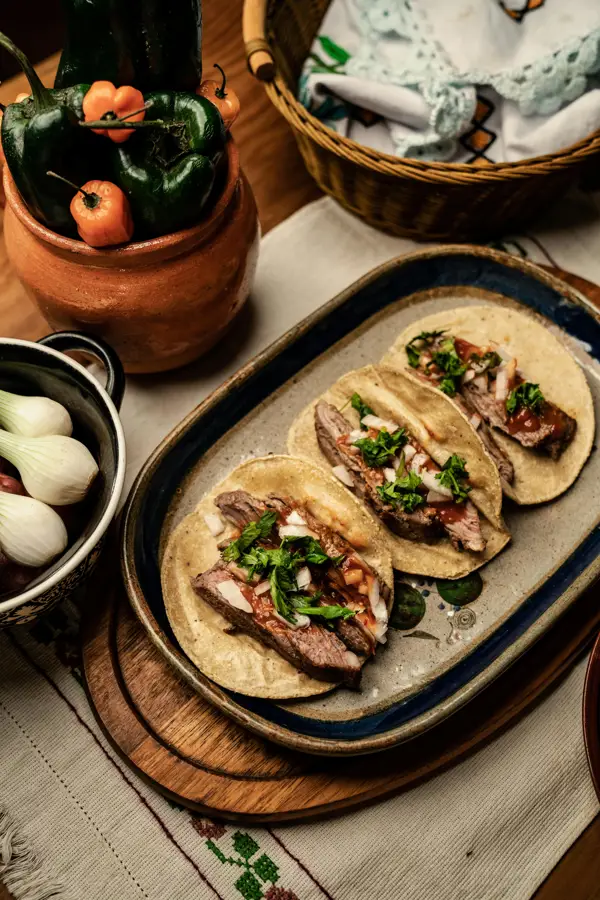The humble taco, a culinary cornerstone of Mexican cuisine, boasts a history as rich and layered as its flavorful fillings. While pinpointing its exact origin is difficult, the word taco itself likely emerged in the late 19th and early 20th centuries in northern Mexico, possibly deriving from the Spanish word taco, meaning plug or small wedge, a reference to the way miners used to wrap explosives in paper. However, the concept of a folded tortilla containing various ingredients is far older, with evidence suggesting similar preparations existed in pre-Hispanic Mexico. Ancient civilizations used corn tortillas to wrap a variety of meats, vegetables, and spices, laying the foundation for the modern taco.
The evolution of the taco is a testament to cultural exchange and adaptation. From its humble beginnings as a simple street food, the taco has conquered palates globally, becoming a ubiquitous dish enjoyed in countless variations. While the classic ground beef taco, often associated with Tex-Mex cuisine, might not be the most historically accurate representation, it serves as a popular and accessible entry point into the world of taco appreciation. In the United States alone, the taco industry is booming, with annual revenue exceeding billions of dollars and an estimated consumption of over 5 billion tacos annually—a testament to its enduring popularity.
The cultural significance of the taco extends far beyond simple sustenance. It represents a powerful symbol of Mexican identity and culinary heritage, often associated with family gatherings, celebrations, and everyday life. Tacos are deeply embedded in the social fabric of Mexican communities, with countless regional variations reflecting unique local ingredients and culinary traditions. From the simple street tacos sold from humble carts to the more elaborate creations found in upscale restaurants, the taco embodies a remarkable adaptability while maintaining its core essence: a delicious and satisfying combination of flavors and textures within a comforting corn or flour tortilla. This recipe focuses on the classic ground beef taco, a beloved entry point into the rich and diverse world of taco culture, providing a foundational understanding that can then be expanded upon with countless variations and additions.
Ingredients and Measurements
This recipe yields approximately 12 classic beef tacos. Accurate measurements are crucial for achieving the perfect balance of flavors in your tacos. Using a kitchen scale is highly recommended for precise ingredient weighing, especially for the spices.
For the seasoned beef:
- 1.5 lbs (680g) ground beef (80/20 blend recommended for optimal juiciness and flavor). Avoid using leaner ground beef, as it can become dry during cooking.
- 1 large yellow onion, finely chopped (approximately 1 cup). Using a food processor for quick and consistent chopping is a time-saver.
- 2 cloves garlic, minced (or 1 teaspoon garlic powder as a substitute). Fresh garlic provides a more vibrant flavor.
- 1 tablespoon chili powder. Adjust to your preferred spice level. Start with 1 tablespoon and add more gradually to taste.
- 1 teaspoon ground cumin. Cumin is essential for that classic taco flavor.
- 1/2 teaspoon smoked paprika. Smoked paprika adds depth and complexity to the flavor profile.
- 1/4 teaspoon cayenne pepper (optional, for added heat). Use with caution, as cayenne pepper is quite potent.
- 1 teaspoon dried oregano. Oregano is a complementary herb that enhances the overall taste.
- 1/2 teaspoon salt. Adjust to your preference, tasting as you go.
- 1/4 teaspoon black pepper. Freshly ground black pepper is always best.
- 1 (14.5 ounce) can diced tomatoes, undrained. The juice from the canned tomatoes adds moisture and flavor to the beef mixture.
- 1/2 cup beef broth (or water). This helps prevent the beef from becoming dry.
For the salsa (recipe for a simple pico de gallo):
- 2 cups chopped tomatoes (about 3 medium tomatoes). Choose ripe, flavorful tomatoes for the best salsa.
- 1/2 cup chopped red onion (about 1/2 small red onion). Red onion adds a nice bite and color.
- 1/2 cup chopped cilantro (about 1/4 cup packed). Fresh cilantro is crucial for authentic flavor.
- 1 jalapeño pepper, seeded and minced (optional, adjust to your spice preference). Remove the seeds and membranes for less heat.
- 2 tablespoons lime juice (about 1 lime). Freshly squeezed lime juice is always best.
- 1/2 teaspoon salt (or to taste). Adjust salt based on your preference and the saltiness of the tomatoes.
For serving:
- 12 corn or flour tortillas. Warm the tortillas slightly before filling for optimal texture.
- Toppings of your choice (shredded lettuce, shredded cheese, sour cream, guacamole, etc.). Offer a variety of toppings to allow for customization.
Note: These measurements are guidelines; feel free to adjust quantities to your taste and the number of servings you require. Always taste and adjust seasonings as needed throughout the cooking process.
Equipment and Utensils
Making delicious classic beef tacos requires the right tools. While you might be able to improvise with some items, having the correct equipment will significantly improve your efficiency and the overall quality of your tacos. This section outlines the essential equipment and utensils you’ll need, along with recommendations for optimal results.
For the Beef: You’ll need a large skillet (at least 12 inches in diameter) for browning and cooking the beef. Cast iron is ideal as it retains heat exceptionally well, leading to a better sear on the beef. However, a good quality stainless steel skillet will also work perfectly. A sturdy wooden spoon or spatula is crucial for breaking up the beef and stirring the ingredients evenly throughout the cooking process. Avoid using metal utensils in a non-stick pan, as they can scratch the surface. A meat thermometer is highly recommended to ensure the beef is cooked to a safe internal temperature of 160°F (71°C). This guarantees the beef is cooked through and safe to consume.
For Preparation and Assembly: You’ll need several cutting boards – one dedicated to raw beef and another for vegetables to avoid cross-contamination. A sharp chef’s knife (8-10 inches) is essential for dicing onions, chopping cilantro, and preparing other ingredients efficiently. A smaller paring knife can be helpful for more delicate tasks. Measuring cups and spoons are necessary for accurate ingredient measurements to ensure consistent flavor and texture. Three medium-sized bowls are recommended: one for the seasoned beef, one for the salsa (if making your own), and one for chopped onions and cilantro.
For Serving: A large serving platter or shallow bowl is ideal for presenting the cooked beef. You’ll need a warm tortilla serving basket or a clean, dry tea towel to keep the tortillas warm and pliable. Small plates or individual serving platters are recommended to make serving easier and more appealing. For ease of filling and eating, consider using tongs to transfer the cooked beef into the tortillas. If you’re using hard or corn tortillas, you might want a small microwave-safe plate to quickly warm them for optimal flexibility.
Optional but Helpful: A food processor can greatly speed up the preparation of your salsa if you’re making it from scratch, allowing for a smoother consistency. A small grill pan can add a smoky flavor to the beef, although this isn’t necessary for achieving delicious tacos. Lastly, consider using a clean kitchen towel to wipe down your workspace as you go to maintain a clean and organized cooking area. This improves efficiency and prevents accidental cross-contamination.
Cleaning up: Remember to immediately wash all utensils and equipment that came into contact with raw meat in hot, soapy water to prevent bacterial growth. Proper sanitation is crucial for food safety.
Beef Preparation (e.g., browning, seasoning)
The foundation of any great beef taco lies in perfectly prepared beef. We’ll be using 1.5 lbs of lean ground beef (around 80/20 blend is ideal) for this recipe. Choosing a leaner ground beef helps prevent excessive grease in your final tacos, contributing to a cleaner, more flavorful result.
Begin by browning the beef in a large skillet over medium-high heat. Add the ground beef to the hot skillet, breaking it up with a spoon as it cooks. Avoid overcrowding the pan; work in batches if necessary to ensure even browning. Overcrowding will steam the beef instead of browning it, resulting in a less flavorful and potentially greasy end product.
As the beef browns, use a spoon to scrape up any browned bits from the bottom of the pan. These browned bits, or fond, contribute significantly to the overall depth of flavor in your tacos. This step is crucial for building a rich and complex flavor profile.
Once the beef is browned (approximately 8-10 minutes), drain off any excess grease. You should aim for a relatively lean mixture; leaving too much grease will make your tacos soggy. Don’t drain completely; some rendered fat adds flavor and richness.
Now it’s time to season the beef. For this classic recipe, we’ll use a simple yet effective blend. Add the following to the skillet:
- 1 teaspoon ground cumin
- 1 teaspoon chili powder
- 1/2 teaspoon smoked paprika
- 1/2 teaspoon garlic powder
- 1/4 teaspoon onion powder
- 1/4 teaspoon cayenne pepper (optional, for added heat)
- 1 teaspoon salt
- 1/2 teaspoon black pepper
Adjust the seasoning to your taste. Some prefer a spicier taco, while others prefer a milder flavor. Feel free to experiment with different spice blends to find your perfect combination. For example, adding a pinch of oregano or a dash of your favorite hot sauce can elevate the flavor profile further.
Stir the seasonings into the browned beef and cook for another 2-3 minutes, allowing the flavors to meld and the spices to bloom. This step ensures that the spices are evenly distributed throughout the beef and that their flavors fully develop. The beef should be cooked through and no longer pink.
Once the beef is cooked and seasoned, remove it from the heat and set aside. You can keep it warm while you prepare the other components of your tacos. Avoid overcooking the beef, as this can make it dry and tough. The goal is tender, flavorful beef that’s perfectly seasoned and ready to be enjoyed in your delicious tacos.
Taco Shell Preparation (if homemade)
Making your own taco shells elevates the taco experience, offering a superior crunch and flavor compared to store-bought options. This section details how to create crispy, flavorful corn tortillas perfect for your classic beef tacos. While seemingly simple, mastering the technique requires attention to detail.
Ingredients: You’ll need 12 corn tortillas (6-inch diameter is ideal), 2 tablespoons of vegetable oil (or your preferred high-heat oil), and a pinch of salt. For extra flavor, consider adding a teaspoon of chili powder or cumin to the oil before cooking.
Preparation: Begin by warming the tortillas. This step is crucial for achieving optimal flexibility and preventing cracking during shaping. You can warm them in a few ways. The most efficient method is to heat a dry skillet over medium heat. Place each tortilla in the hot pan for about 15-20 seconds per side, or until slightly pliable. Alternatively, you can microwave them wrapped in a damp paper towel for 30 seconds, or steam them for a few minutes.
Shaping the Shells: Once warmed, carefully place each tortilla on a flat surface. You’ll need a shallow, oven-safe skillet or baking sheet for this next step. Using a small, clean bowl or a similar-sized object (about 4-inch diameter), gently press the center of the warmed tortilla to create a slight indentation. This indentation will help the tortilla hold its shape while cooking and prevent it from collapsing. Avoid pressing too hard; you want a gentle indentation, not a hole.
Cooking the Shells: Preheat your oven to 375°F (190°C). Lightly brush both sides of each tortilla with vegetable oil, ensuring even coating. Season lightly with salt (and chili powder/cumin if using). Carefully place the shaped tortillas in the prepared skillet or on the baking sheet. Ensure there is some space between each tortilla to allow for even air circulation and crisping.
Baking and Crispness: Bake for 8-10 minutes, keeping a close eye to prevent burning. The tortillas should be golden brown and crispy. For extra crispiness, you can broil them for the last minute or two, but stay vigilant to avoid over-browning. Watch carefully, as ovens can vary in temperature. Remove the shells from the oven and let them cool slightly on a wire rack before filling with your delicious beef taco mixture. This allows them to fully crisp and prevents them from becoming soggy from the filling.
Troubleshooting: If your tortillas are breaking during shaping, they are likely not warm enough. Reheat them gently before attempting to shape them again. If they are burning too quickly in the oven, reduce the temperature slightly or check for even spacing on the baking sheet. Experimentation is key to perfecting your homemade taco shell technique. Enjoy the satisfaction of making your own delicious and perfectly crisp taco shells!
Salsa Preparation
Making your own salsa elevates these classic beef tacos to a whole new level. The freshness and vibrant flavor are unmatched by store-bought varieties. This recipe focuses on a classic tomato-based salsa, but feel free to experiment with your favorite ingredients and spice levels!
Ingredients:
- 2 pounds ripe Roma tomatoes, roughly chopped (about 4-5 large)
- 1 medium white onion, finely chopped
- 1 jalapeño pepper, seeded and minced (remove more seeds for extra heat, or leave some in for a milder salsa)
- 1/2 cup chopped fresh cilantro
- 1/4 cup lime juice (about 2 limes)
- 1 teaspoon ground cumin
- 1/2 teaspoon sea salt
- 1/4 teaspoon black pepper
- Optional: 1/4 cup finely chopped red onion for added bite and visual appeal
Instructions:
1. Preparing the Tomatoes: The key to a great salsa is using ripe, flavorful tomatoes. Avoid using mealy or unripe tomatoes, as they will significantly impact the final taste. You can either chop the tomatoes by hand or use a food processor for a quicker, more consistent chop. If using a food processor, pulse the tomatoes a few times until they’re roughly chopped, but not pureed.
2. Combining the Ingredients: In a medium-sized bowl, combine the chopped tomatoes, white onion, jalapeño, cilantro, lime juice, cumin, salt, and pepper. If using, add the red onion now. Thoroughly mix all ingredients to ensure even distribution of flavors.
3. Adjusting the Consistency: Some prefer a chunky salsa, while others prefer a smoother consistency. If you prefer a smoother salsa, you can use an immersion blender to partially blend the mixture. Blend in short bursts to avoid over-processing and creating a puree. Taste and adjust seasoning as needed. You may want to add more lime juice for acidity, salt for saltiness, or jalapeño for heat.
4. Resting the Salsa: For the best flavor, allow the salsa to rest for at least 15-30 minutes at room temperature. This allows the flavors to meld and deepen. Cover the bowl with plastic wrap to prevent it from drying out. You can also refrigerate the salsa for later use, but the flavors will be slightly muted when cold.
Professional Recommendations:
- Use high-quality ingredients: The flavor of your salsa is directly dependent on the quality of your ingredients. Fresh, ripe tomatoes and herbs make all the difference.
- Don’t be afraid to experiment: This recipe is a starting point. Add other ingredients like diced mango, corn, or avocado to create your own unique salsa variations.
- Taste and adjust: Taste your salsa throughout the process and adjust the seasoning to your liking. Everyone’s palate is different!
- Serve immediately or chill: While chilling enhances the freshness, serving the salsa immediately after preparing offers the most vibrant flavors.
Enjoy your homemade salsa with your delicious beef tacos!
Assembly Instructions
With your perfectly seasoned beef and vibrant salsa prepared, it’s time to assemble your classic beef tacos! This stage is all about creating a balanced and delicious bite, so pay attention to detail.
First, warm your tortillas. This is crucial for achieving the best texture. You can warm them several ways: in a dry skillet over medium heat for about 30 seconds per side, until pliable and slightly charred; in the microwave wrapped in a damp paper towel for 15-20 seconds; or even in a warm oven (300°F) for 5-7 minutes. Avoid over-warming, as this will make them brittle and difficult to handle.
Once warmed, carefully remove the tortillas. Using tongs is recommended to avoid burning your fingers. Lay them flat on a clean work surface. For easier handling, consider lightly oiling the tortillas with a neutral oil like canola or vegetable oil. This will prevent sticking and improve the overall texture.
Next, we’ll add the seasoned beef. Aim for approximately 1/3 to 1/2 cup of beef per taco, depending on the size of your tortillas and your appetite. Evenly distribute the beef across the center of each tortilla, leaving about a half-inch border to allow for easy folding.
Now, it’s time for the salsa! Start with 1-2 tablespoons of your freshly made salsa per taco. You can always add more later, but it’s easier to add than to take away. Spread the salsa evenly over the beef, ensuring complete coverage for a harmonious flavor profile. Consider the heat level of your salsa when determining the quantity; adjust to your preference.
Optional additions can elevate your taco experience. Consider adding shredded lettuce (about 1/4 cup per taco), diced onions (1-2 tablespoons per taco), shredded cheese (1-2 tablespoons per taco), or a dollop of sour cream or guacamole (1-2 tablespoons per taco). Layer these ingredients carefully to avoid overcrowding the taco. Remember to distribute them evenly for a balanced flavor in each bite.
Finally, it’s time to fold! There are several ways to fold a taco: You can fold it in half, creating a half-moon shape, or you can fold it into thirds, creating a more compact taco. Choose your preferred method and fold gently to avoid spilling the delicious filling. Serve immediately and enjoy your homemade classic beef tacos!
Pro Tip: For a truly authentic experience, consider using smaller corn tortillas for a more traditional presentation. If using larger flour tortillas, you may want to adjust the filling quantities accordingly.
Recommendations for Classic Beef Tacos with Salsa
To elevate your Classic Beef Taco experience, consider these recommendations for preparation, serving, and storage. Proper preparation is key to achieving the perfect balance of flavors and textures. Ensure your beef is cooked thoroughly to an internal temperature of 160°F (71°C) to ensure food safety. Don’t overcrowd the pan when browning the beef; work in batches to achieve a good sear and prevent steaming. Allow the beef to rest for a few minutes after cooking to allow the juices to redistribute, resulting in a more tender and flavorful final product.
For the salsa, freshness is paramount. Use ripe, high-quality tomatoes, onions, and cilantro. Adjust the level of spiciness to your preference by adding more or less chili. Consider making your salsa from scratch for a superior flavor profile compared to store-bought options. Experiment with different types of chilis for varying heat levels and flavor complexity. A good quality lime adds brightness and balances the richness of the beef.
Serving suggestions are crucial to a complete taco experience. Warm your tortillas gently, either on a griddle, in a dry skillet, or even in the microwave wrapped in a damp paper towel. This prevents them from becoming brittle and enhances their flexibility. Offer a variety of toppings beyond the salsa, such as shredded lettuce, diced tomatoes, shredded cheese (cheddar, Monterey Jack, or a Mexican blend work well), sour cream or Mexican crema, and guacamole. Consider adding pickled onions or jalapeños for an extra layer of flavor and texture. Presentation matters! Arrange the tacos attractively on a platter, garnished with fresh cilantro sprigs.
Storage is important for maintaining the quality of your tacos. Leftover beef can be stored in an airtight container in the refrigerator for up to 3-4 days. Salsa can also be stored in an airtight container in the refrigerator for up to 3-4 days, but its flavor may diminish slightly over time. Do not store the assembled tacos; assemble them fresh when ready to serve to maintain optimal texture and flavor. Reheating leftover beef should be done gently to avoid drying it out; consider adding a little water or broth if needed.
Complementary dishes enhance the overall dining experience. Serve your tacos with a side of Mexican rice, refried beans, or a simple salad. A vibrant and refreshing side salad with a light vinaigrette can cut through the richness of the tacos. Consider offering chips and guacamole as an appetizer. Remember to consider dietary restrictions and preferences – offer vegetarian or vegan alternatives if necessary.
Nutritional Information (per serving, approximate): This will vary greatly depending on the size of the taco, the amount of beef, and the toppings used. However, a typical serving might contain approximately 350-500 calories, with varying amounts of protein (20-30g), fat (20-30g), and carbohydrates (30-40g). Sodium content will also vary depending on the ingredients used. This information is an estimate and should not be considered a precise nutritional analysis. For accurate nutritional information, use a nutrition calculator and input the specific ingredients and quantities used in your recipe.





